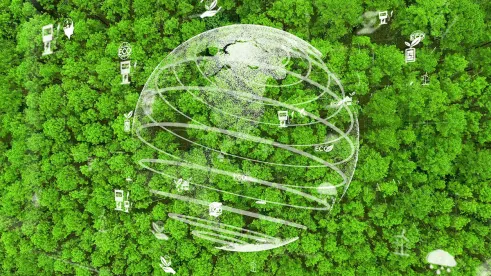For several years, Congress has considered legislation to support nature-based greenhouse gas (GHG) reductions in the agriculture and forestry sectors. That legislative vision recently became law through the Consolidated Appropriations Act of 2023, which President Biden signed on December 29, 2022. The Appropriations Act authorized $1.7 trillion of spending to fund the federal government for Fiscal Year 2023 and beyond. This massive bill includes—and crucially, funds—the Growing Climate Solutions Act.
The Growing Climate Solutions Act was first introduced to the Senate in 2020 with bipartisan support and was later re-introduced in 2021. With the recent passage and funding of the Growing Climate Solutions Act, the U.S. Department of Agriculture (USDA) may now expend up to $4.1 million over fiscal years 2023 to 2027 to create and administer a new “Greenhouse Gas Technical Assistance Provider and Third-Party Verifier Program” to provide U.S. farmers, ranchers, and private forest landowners with technical guidance for reducing GHG emissions and sequestering atmospheric carbon on working lands. The program would also guide third-party entities that verify and validate claimed GHG reductions to support the generation of credits in voluntary carbon offset markets. The legislation has the potential to advance “climate-smart” agriculture and agricultural commodities in the United States, through both new and existing USDA programs, while expanding access to carbon markets for U.S. farmers, ranchers, and foresters.
Key Takeaways
-
The Growing Climate Solutions Act (the “Act”) is the first congressional effort to help farmers, ranchers, and private forest landowners to participate in voluntary carbon offset markets.
-
To assist these groups, the Secretary of Agriculture must publish a list of widely accepted industry protocols to support the calculation and verification of GHG reductions used to generate meaningful and marketable credits.
-
USDA also may establish a voluntary program to expand access to information, technical assistance, and direct services related to developing and marketing carbon credits.
-
A list of voluntarily registered “covered entities,” administered by USDA, would be deployed to improve access to information and increase transparency, consistency, and service reliability across U.S. carbon markets.
-
The Act creates an Advisory Council, broadly representative of the agricultural and private forest sectors, to administer the program and conduct periodic assessments of the credit markets.
-
USDA is expected to accept public comment on these topics in 2023.
Background
Voluntary carbon offset markets have expanded rapidly over the past five years, with a renewed focus on nature-based carbon reductions and carbon removals that occur through natural processes such as the sequestration of carbon in soils, forests, and other organic matter. As carbon markets expand, access may be uneven—particularly for smaller farmers, foresters, and ranchers. In addition, as a voluntary market, there is no single clearinghouse or resource that potential “carbon farmers” can turn to for advice or assess the relative strengths of different carbon offset programs and methodologies. The Growing Climate Solutions Act aims to address these (and other) aspects of carbon markets and increase overall participation in the markets with the dual goal of reducing net U.S. GHG emissions and helping U.S. farmers, ranchers, and forest landowners to access—and profit from—these emerging markets.
Details of the Growing Climate Solutions Act
The main purpose of the Growing Climate Solutions Act is to facilitate the participation of more U.S. farmers, ranchers, and private forest landowners in carbon credit markets. Following a public comment period, the Act directs the Secretary of Agriculture to identify and publish a list of “widely accepted,” market-based GHG reduction protocols or methodologies designed to ensure the consistency, reliability, effectiveness, efficiency, and transparency of credit markets in the agriculture and forestry sectors. (The statute does not define what “widely accepted” means in this context.)
Additionally, the Secretary must publish “widely accepted” qualifications for “covered entities” to provide technical assistance to farmers, ranchers, and private forest landowners through the USDA program. Technical assistance through covered entities is intended to help these groups overcome barriers to entry into credit markets.
The Act also empowers the Secretary to administer a program to voluntarily register covered entities that provide related technical assistance and meet certain standards set by USDA. USDA would then publish a list of registered covered entities on a website. To register and be listed, covered entities would have to demonstrate expertise in and perform in accordance with best management practices for agricultural and forestry activities that prevent, reduce, or mitigate GHG emissions (including carbon sequestration). The Act also instructs USDA to ensure, to the maximum extent practicable, that all registered covered entities act in good faith as they provide realistic estimates of the costs and revenues associated with carbon offset projects to their clients.
Finally, the Act instructs USDA to establish an Advisory Council to periodically review and recommend changes to the department’s published lists of protocols and qualifications, suggest additional methods to reduce barriers to entry, and advise on the evolving state of the credit markets. The Advisory Council must broadly represent the agriculture and private forest sectors, including beginning, socially disadvantaged, limited resource, veteran farmers, ranchers, and private forest landowners.
Looking Forward
With the Growing Climate Solutions Act, Congress has taken a significant step to help the agriculture and forestry sectors participate in private carbon markets and engage in actions to reduce GHG emissions and increase natural carbon sequestration. USDA action under the Act will essentially operate as an “opt-in” stamp of approval for different practices and practitioners in the voluntary environmental credit markets.
As noted above, the Act is not entirely self-executing, and USDA has regulatory discretion in how it proceeds. The agriculture and forestry industries and GHG market participants will want to follow USDA’s progress over the coming months as it considers whether and how to implement the various aspects of the programs included in the Act.






 />i
/>i


